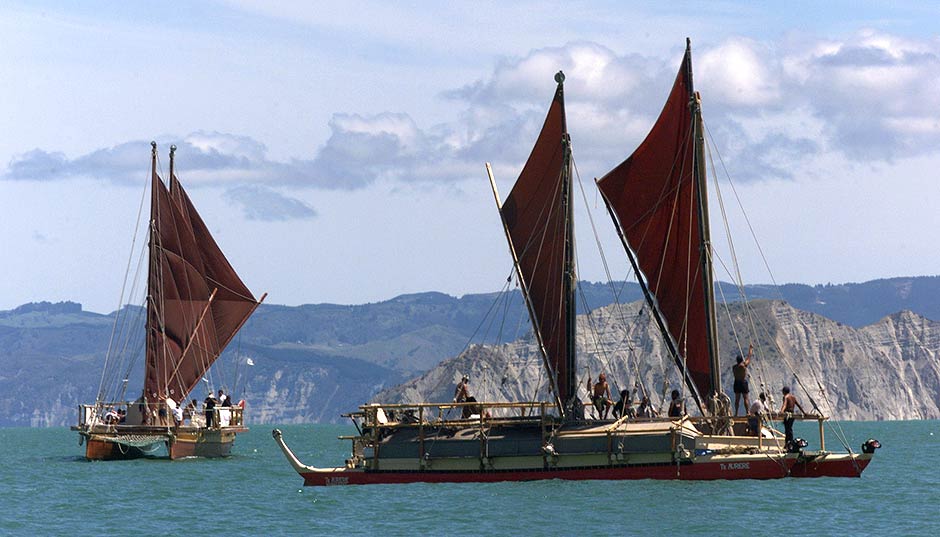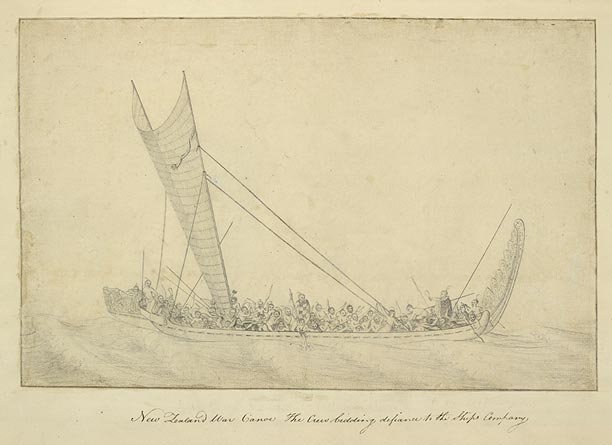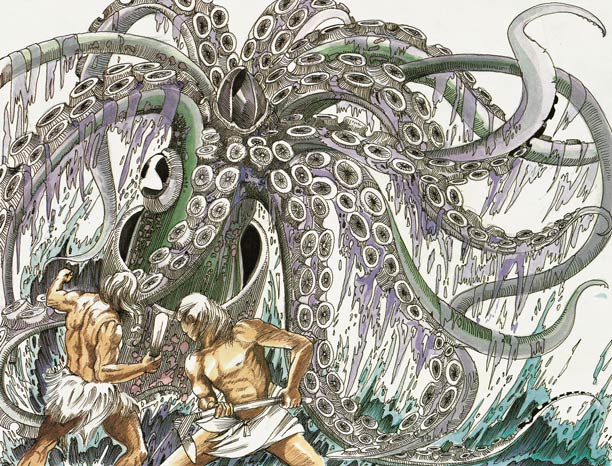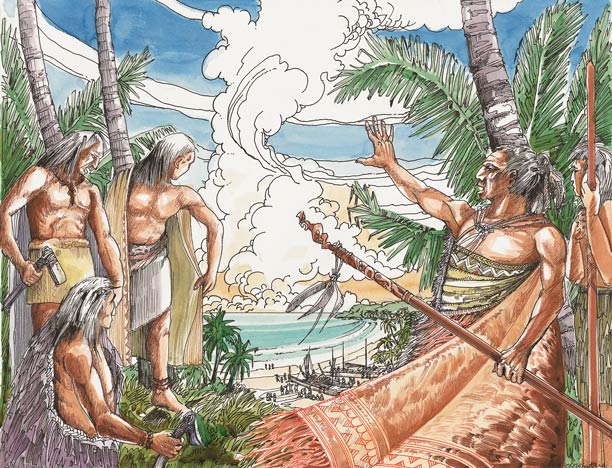
Te Moana-nui-ā-Kiwa, the Pacific Ocean, was one of the last areas of the earth to be explored and settled by human beings. It was only around 3000 years ago that people began heading eastwards from New Guinea and the Solomon Islands into the Pacific Ocean.
Great skill and courage was needed to sail across vast stretches of open sea. Between 1100 and 800 BCE these voyagers reached Fiji and West Polynesia, including Tonga and Samoa.
Around 1000 years ago people began to inhabit the central East Polynesian archipelagos, settling the closest first.

The movement of peoples around the Pacific and from Asia into the Pacific over the last 6,000 years.
New Zealand was the last significant land mass outside the Arctic and Antarctic to be settled. The Polynesian culture emerged in Fiji, Samoa and Tonga from the earlier Lapita culture, which had formed from the mixing of the Melanesian peoples already living in Near Oceania with migrants from the vicinity of Taiwan. Around the end of the first millennium CE, Polynesians sailed east into what is now French Polynesia before migrating to the Marquesas and Hawaii, Rapa Nui/Easter Island and New Zealand, the far corners of the 'Polynesian triangle'.
A broad range of evidence – including radiocarbon dating, analysis of pollen (which measures vegetation change) and volcanic ash, DNA evidence, genealogical dating and studies of animal extinction and decline – suggests that New Zealand's first permanent settlements were established between 1250 and 1300.
These migrants, who sailed in double-hulled canoes from East Polynesia (specifically the Society Islands, the southern Cook Islands and the Austral Islands in French Polynesia), were the ancestors of the Māori people.

British Library Board. Ref: 23920 f.48
This double canoe was sketched off the New Zealand coast in 1769 by Herman Spöring. It has a double spritsail rig and appears to be made from two canoes of different length and design lashed together. Archaeologist Atholl Anderson argues that the double spritsail was the type of sailing rig most likely to have been used by the Polynesian voyagers who reached New Zealand in the 13th century.
Kupe, Toitehuatahi and Turi
According to many iwi narratives, Kupe was the first Pacific explorer to discover the islands of New Zealand. Stories about his voyages in his canoe, the Matawhaorua or Matahorua, differ from region to region but often feature a fight with a great wheke (octopus). Many New Zealand place names, preserved by later generations of Māori people, recall his journey.

Cliff Whiting, for the New Zealand Geographic Board, Crown Copyright reserved.
Kupe fighting the wheke.
Toitehuatahi (Toi), another early visitor from Hawaiki (the traditional Māori place of origin), is an important ancestor for many Māori people.
One of the captains remembered as voyaging to New Zealand was Turi, of the Aotea canoe. Stories of Turi and Kupe are intertwined throughout the Pacific. Tradition says that Turi followed Kupe’s instructions when sailing from Hawaiki to New Zealand via Raoul Island in the Kermadecs. The canoe made landfall in Waitematā Harbour, then travelled down the west coast of the North Island from Aotea Harbour, named after the canoe, to Pātea in Taranaki, where Turi and his people settled; many places on this coast are named for events that occurred during this journey.

Cliff Whiting, for the New Zealand Geographic Board, Crown Copyright reserved.
Turi, the captain of the Aotea canoe.
Migration
Although it was once thought that the ancestors of Māori came to New Zealand in a single ‘great fleet’ of seven canoes, we now know that many canoes made the perilous voyage. Through stories passed down the generations, tribal groups trace their origins to the captains and crew of more than 40 legendary vessels, from the Kurahaupō at North Cape to the Uruao in the South Island.
Today, Māori whakapapa to these captains and crew. For more information about each of the waka and their voyages of exploration, see Te Ara's entries on Canoe navigation and Canoe traditions.
Over the centuries that followed, Māori developed a detailed knowledge of Aotearoa New Zealand’s coast and interior, and its flora and fauna. See Te Ara for more on Māori New Zealanders and their world.
Rēkohu
Sometime between 1300 and 1550, Māori from New Zealand settled on the Chatham Islands (Rēkohu), more than 750 km east of the mainland. For around 400 years their descendants lived on the Chatham Islands without contact with other peoples, and the unique Moriori culture developed. See Te Ara for more on Rēkohu and the Moriori.
Find more about Pacific voyaging on Te Ara
Objects that tell stories
-

Kupe’s anchor
-

Māori star compass
-

Double-hulled canoes
-

Fishing lure
-

Carved dog
-

Voyaging ancestors
-

Anchor stone of the Tokomaru
-

Māui’s fish-hook
-

Memorial to the Aotea
Further Information
'Pacific migrations', on Te Ara - the Encyclopedia of New Zealand
‘Ideas of Māori origins’, on Te Ara - the Encyclopedia of New Zealand
‘Canoe traditions’ on Te Ara - the Encyclopedia of New Zealand
'Wayfinding revival’, article on the NZ Science Learning Hub website
Polynesian Voyaging Society – founded in Hawaii in 1973, the Polynesian Voyaging Society builds replica canoes and sails them using traditional navigation methods.
The Canoe is the People: Indigenous Navigation in the Pacific – a website designed mostly for Pacific youth which honours and explores the knowledge and skills of traditional Pacific wayfinding
Kupe Voyaging by the Stars – this 1993 documentary shows Hekenukumai 'Hector' Busby, from Northland, lead the construction of a waka hourua (double-hulled canoe), then retrace Kupe's course across the Pacific, back to Rarotonga. NZ On Screen
He Korero Purakau mo nga taunahanahatanga a nga tupuna: Place names of the ancestors, a Maori oral history atlas. Wellington: New Zealand Geographic Board, 1990
Atholl Anderson, ‘Finding Tonganui: East Polynesian Seafaring and Migration to New Zealand’, in Frances Steel (ed.), New Zealand and the sea: historical perspectives, Bridget Williams Books, Wellington, 2018
Atholl Anderson, ‘Speaking of migration, AD 1150–1450’, in Atholl Anderson, Judith Binney and Aroha Harris (eds), Tangata whenua: an illustrated history, Bridget Williams Books, Wellington, 2014



Community contributions